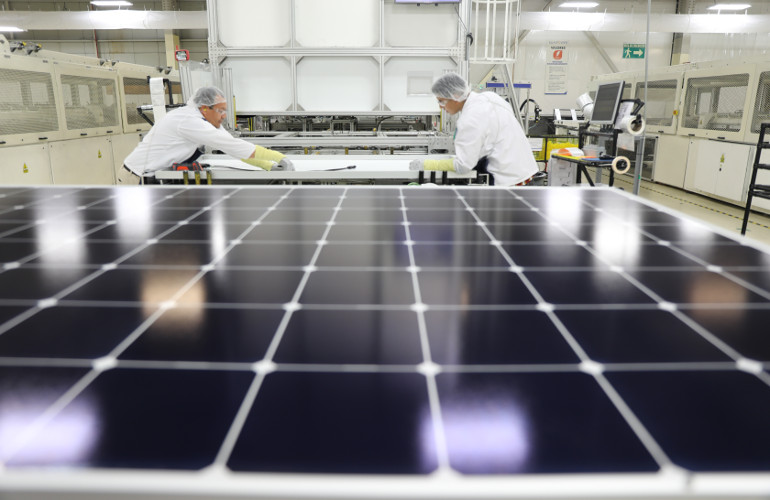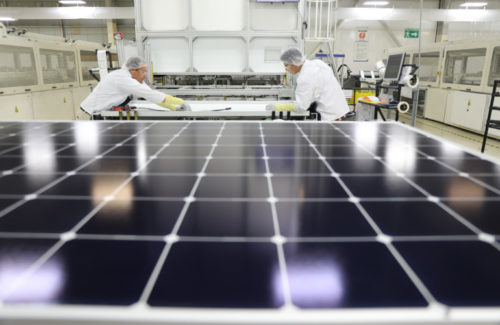After years of planning, Maxeon Solar Technologies has announced it will start a 3-GW solar cell and panel factory in Albuquerque, New Mexico. The plant will make TOPCon solar cells and the company’s Performance line of solar modules.
Maxeon has long had its sights set on establishing U.S. manufacturing, first announcing a plan in early 2021. The company was waiting for favorable credits to be included in the Inflation Reduction Act and to reach the final steps in its loan application through the Dept. of Energy.
In order to receive a DOE loan through the Energy Policy Act of 2005 Title XVII program, the recipient is required to be working with new or significantly improved technologies. Maxeon told Solar Power World in 2022 that it was complying with that requirement with its next-generation product that then-CEO Jeff Waters said is “a new technology that’s not done in China or broadly across the [other solar panel brands].” Specifically with its next-gen solar panel for the utility market, the company is innovating back-end metallization processes.
The total investment into the Albuquerque plant is expected to be over $1 billion. Maxeon is currently in the due diligence stage of its DOE loan application and has not yet received the loan guarantee.
“Thanks to the support of the Biden administration, the U.S. is now poised to re-shore and scale up a domestic solar supply chain,” commented Bill Mulligan, Maxeon CEO. “This will enhance national energy security and create a new cadre of well-paying manufacturing jobs. Maxeon is well positioned to play a significant role in this process by virtue of our proven experience in deploying and operating world-class solar cell and panel technology. We see tremendous opportunity to help the country advance its clean energy agenda while generating strong local economic impact.”
Maxeon expects to begin construction on the new plant in the first quarter of 2024, with factory ramp-up in 2025. Maxeon has selected a 160-acre site in Mesa Del Sol (just to the south and west of the famed Sandia National Laboratories) and is designing the complex to include solar cell fabrication, panel assembly, a warehouse and administrative offices. Once complete, Maxeon estimates the new facility will create up to 1,800 jobs, including manufacturing and engineering jobs.
“The Inflation Reduction Act has catalyzed a new chapter in America’s energy transition. As a company that started in Silicon Valley 38 years ago, we are proud to be bringing U.S.-developed technologies back home and to contribute to the reshoring of a domestic solar supply chain,” Mulligan said.
The Singapore-headquartered company is the manufacturing spinoff of installation company SunPower. Maxeon also makes solar cells and panels at its factory in Malaysia, assembles panels in the Philippines and recently expanded its panel assembly factory in Baja California, Mexico.
Joining Maxeon’s 1.8-GW annual capacity plant in Mexico, this new U.S. factory will bring the company’s North American solar panel manufacturing capacity to 4.8 GW. Due to strong customer demand, Maxeon is also evaluating plans to upsize the Mesa Del Sol facility to 4.5 GW.
Maxeon has two product families: the Maxeon series of solar panels for the residential and light commercial markets, and the Performance series for the utility-scale market. The company is currently under an exclusive supply agreement with SunPower for its Maxeon series of interdigitated back contact (IBC) technology panels through 2025. The Performance line will be made at this new plant.
Maxeon joins Enel, Meyer Burger, Qcells, Silfab and Solar4America/SPI Energy as companies planning to start silicon solar cell manufacturing in the United states. Solar cells are one of the subcomponents required for an American solar panel to qualify for domestic content tax credits. U.S. solar cell manufacturers also can receive a manufacturing tax credit of 4¢/WDC through the IRA.


